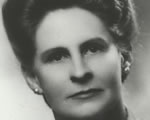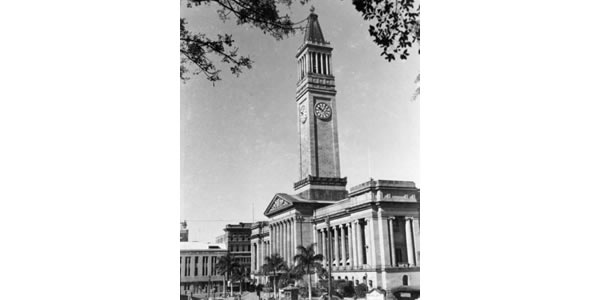AustLit
-
Brisbane Culture
Brisbane was marked significantly by the changes of World War 11; Post-war Brisbane experienced the rise of unionism, political awareness, civil/women’s rights movements and a growing artistic culture (Barnard). It is from within the context of a post-war society that Eunice Hanger was most active within Brisbane. As a result, the question of Brisbane culture during the mid 20th century is of great consequence.
-
Long before World War II, women had been relegated into traditional roles of housewife and mother. However, war time exigencies between 1939-1945 promoted women into the public arena, liberating them from their previously perceived role of nurturer. National conscription positioned women as not only primary care-givers, but as key financial providers, and the ultimate backbone behind the continuation of Australia’s industry (Johansen 1).
Brisbane in particular, relied on a work-force of women to aid the war effort. For instance, women had the opportunity to work in areas that had previously been the province of the male work force, such as the production of munitions. Furthermore, the management of state-wide funds raised to help the war effort took place in Brisbane (15).
As a result, post-war society marked an era of steady social change for woman on national and state levels during the years of post-war reconstruction, this was particularly apparent with the leadership of Robert Menzies in 1949 and continued well into the beginning of the second wave of feminism in the 1960s (2).
-
Though Brisbane was commonly perceived to be struggling with its cultural identity immediately after WWII, there is much evidence to suggest otherwise (Hatherelle 8). Post WWII saw a surprising amount of ‘high’ cultural activity take place, particularly in the instances of poetry and painting (2).
Brisbane’s post-war artistic culture was often expressed through the lens of modernism, which corresponded to Brisbane’s experience of growing urbanisation. Most apparent to the modernist form are the architectural designs that flourished during the post-war era and are still evident in Brisbane today (6). The formation of the Brisbane branch of the Contemporary Art Society (CAS) was elemental to the enhancement of Brisbane's artistic culture in regards to fostering the skills of local Brisbane artists through exhibitions and purchases.
Brisbane's literary scene was steadily developing and was further fostered by literary institutions. The foundation of the English Association of Queensland (EAQ) (formed in 1922 and relaunched following a war-time interlude in 1947), and the more established Commonwealth Literary Fund (1908-1973) was to provide to authors funding, as well as run popular lectures to the public immediately after WWII (126). Eunice Hanger was actively involved in both organisations and was often invited to lecture. She was most involved with the EAQ, which was primarily comprised of members drawn from university, college and school teachers of literature and language - It was explicitly concerned with curriculum and pedagogy as well as with wider literary-cultural issues and the organisation exercised great control over the high school syllabus working to place local literary culture in an international context.
In order to mark the Queensland Centenary in 1959, the association held lectures on various aspects of literature, including drama which was the subject Eunice Hanger lectured in (127).
The connection between war and post-war is central in considering the coherence of this period. The early lives of most cultural producers in Brisbane (including Hanger) were in some way shaped by the war and its immediate aftermath. Eunice Hanger was an active participant in cultural production within Brisbane, and was elemental to the development of Brisbane's literary heritage, as well as the foundation of Brisbane's 'little theatre' scene.
-
An identifiable consequence of the war-time era was the development of the Little Theatre movement, comprising of members engaged in the amateur preparation and performance of plays to the local community audiences. Little theatres continues to shape the theatrical landscape of Queensland and, to date, there have been approximately 113 groups formed since the war-time era in Queensland (Radbourne 7).
The Little Theatre movement was propagated during the war and post-war years by a lack of facilities for staging the performing arts, the disinclination of professional artists to visit Queensland, and the rejection of Queensland as an area in which to establish a commercial theatrical enterprise - many commercial enterprises tended to favour the southern states (Johansen 349).
The Little Theatre movement operated to effectively fill the artistic deficit that Queensland communities were experiencing, allowing individuals to provide entertainment for themselves and local communities.
In an interview conducted with Betty Cosgrove, a Little Theatre participant, she testified that Little Theatre was popular in Brisbane during the 1940-1965 period (376). She said:
“There were very few professional shows that were brought up [to Brisbane] but there were several Little Theatre groups. Twelfth Night was one that kept on. The University had one but we didn’t do much. A couple of melodramas, a couple of Oscar Wilde plays. That was during the war years…. amateur theatres used the Albert Hall and then they had their own theatre in the SGIO.”
Eunice Hanger identified the importance of the flourishing Little Theatre movement, and involved herself in various aspects of the movement. She further joined local theatre groups and participated in acting, directing and managing particular plays. Of particular note is her participation in the Twelfth Night Theatre, founded by Rhoda Felgate in 1936. Felgate identified that there was room in amateur theatre for growth and development and fought to produce modern, new plays by leading contemporary playwrights.
Hanger experienced most of her playwriting success through Twelfth Night Productions such as Upstage , in April 1950 and Flood, in October 1955.
The Twelfth Night Theatre provided Hanger with an opportunity to present her own works as well as other’s local works which she identified as of value (Radbourne 239).
You might be interested in...





